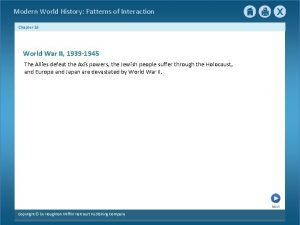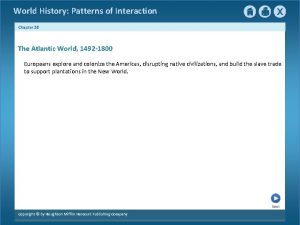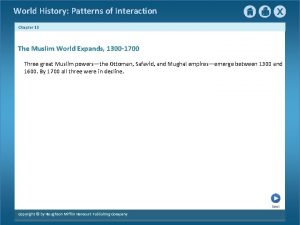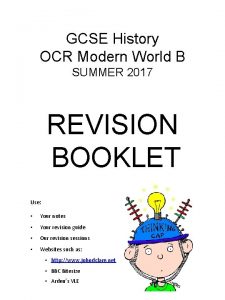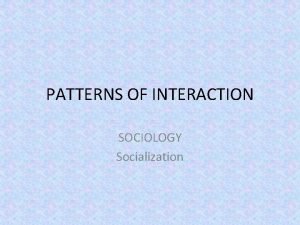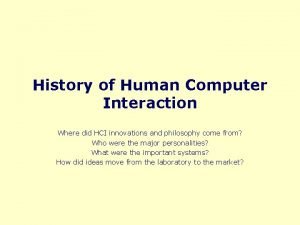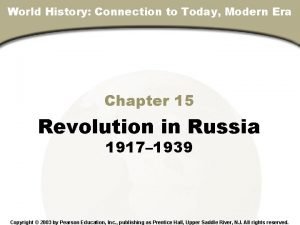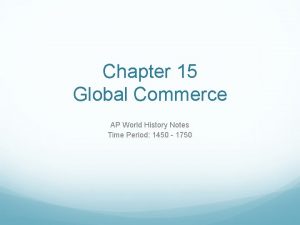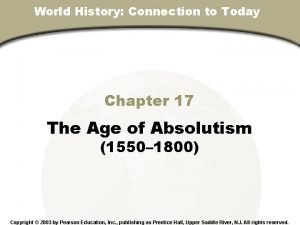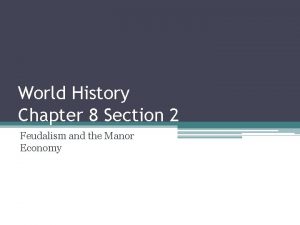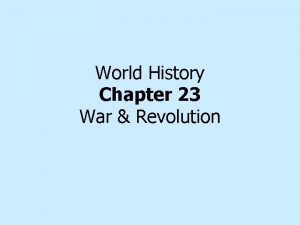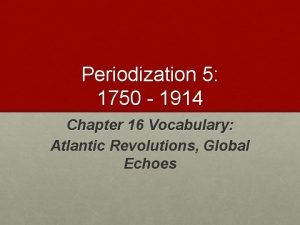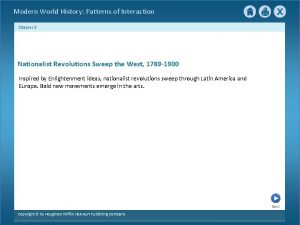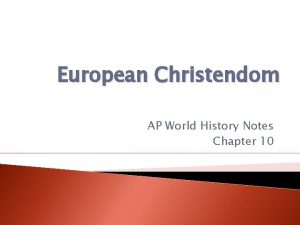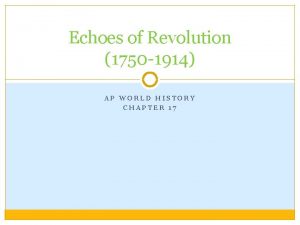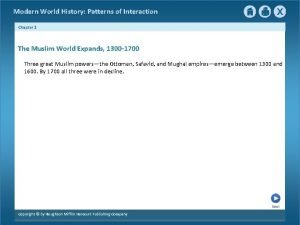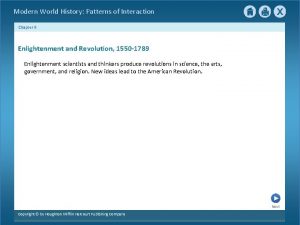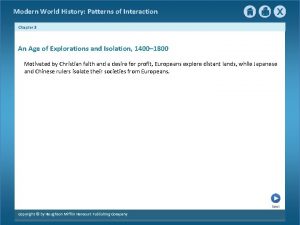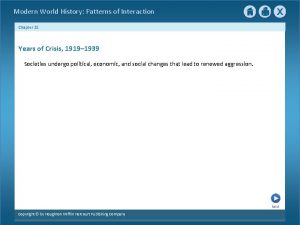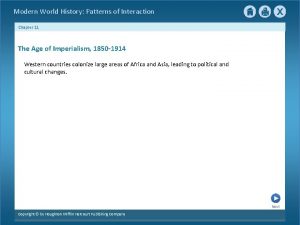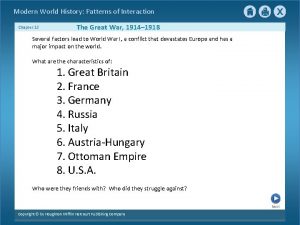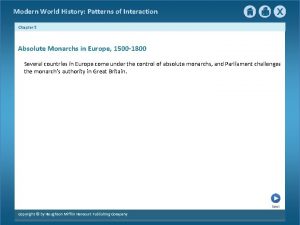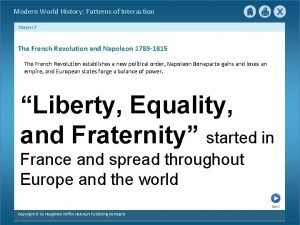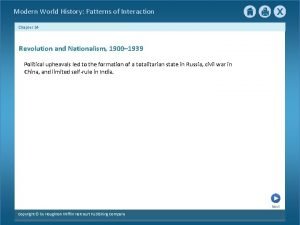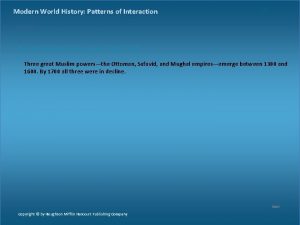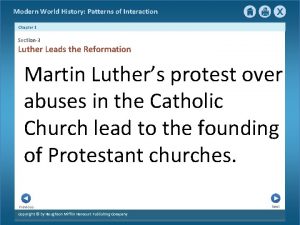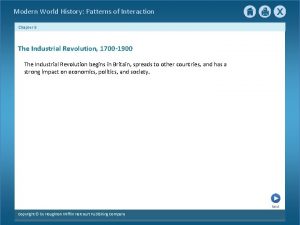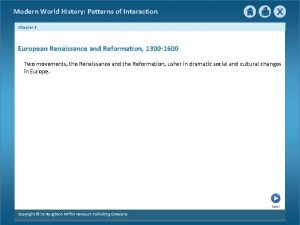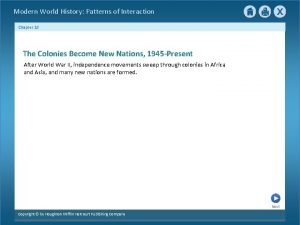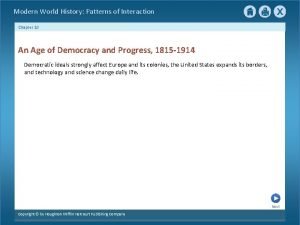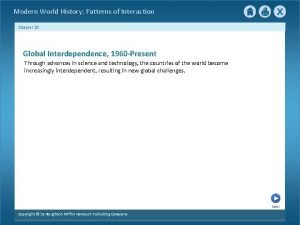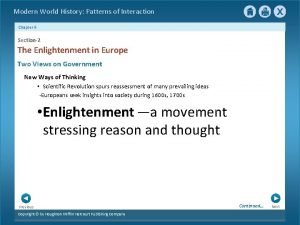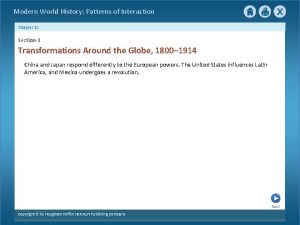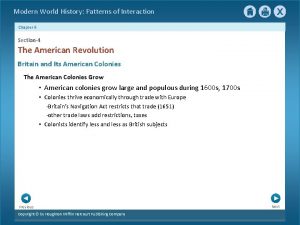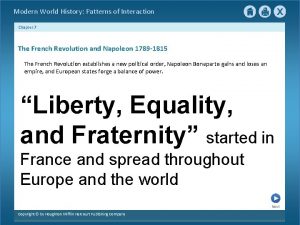Modern World History Patterns of Interaction Chapter 7
































- Slides: 32

Modern World History: Patterns of Interaction Chapter 7 The French Revolution and Napoleon 1789 -1815 The French Revolution establishes a new political order, Napoleon Bonaparte gains and loses an empire, and European states forge a balance of power. Next Copyright © by Houghton Mifflin Harcourt Publishing Company

Modern World History: Patterns of Interaction Chapter 7 The French Revolution and Napoleon 1789 -1815 SECTION 1 The French Revolution Begins SECTION 2 Revolution Brings Reform and Terror SECTION 3 Napoleon Forges an Empire SECTION 4 Napoleon’s Empire Collapses SECTION 5 The Congress of Vienna Previous Copyright © by Houghton Mifflin Harcourt Publishing Company Next

Modern World History: Patterns of Interaction Chapter 7 Section-1 The French Revolution Begins Economic and social inequalities in the Old Regime help cause the French Revolution. Previous Copyright © by Houghton Mifflin Harcourt Publishing Company Next

Modern World History: Patterns of Interaction Chapter 7 Section-1 The French Revolution Begins The Old Order The Old Regime • Old Regime—social and political system in France during the 1770 s • Estates—three social classes of France’s Old Regime The Privileged Estates • First Estate—Catholic clergy—own 10 percent land, pay few taxes • Second Estate—rich nobles— 2 percent population, own 20 percent land Previous Copyright © by Houghton Mifflin Harcourt Publishing Company Continued… Next

Modern World History: Patterns of Interaction Chapter 7 The Old Order {continued} The Third Estate • 97 percent of people are peasants, urban workers, middle class • Have few privileges, pay heavy taxes, want change Previous Copyright © by Houghton Mifflin Harcourt Publishing Company Next

Modern World History: Patterns of Interaction Chapter 7 The Forces of Change Enlightenment Ideas • Enlightenment ideas inspire some in Third Estate Economic Troubles • High taxes and rising costs damage economy by 1780 s • King Louis XVI and his wife Marie Antoinette known for extravagance • Louis doubles nation’s debt; banks refuse to lend more money A Weak Leader • Louis’s poor decisions and lack of patience add to France’s problems • He calls Estates-General —meeting of representatives from all three estates Previous Copyright © by Houghton Mifflin Harcourt Publishing Company Next

Modern World History: Patterns of Interaction Chapter 7 Dawn of the Revolution The National Assembly • Third Estate has little power under old rules • Sieyès persuades them to make major changes in French government • Third Estate sets up National Assembly—new legislature to make reforms • Tennis Court Oath—delegates decide to write new constitution for France Storming the Bastille • Rumors fly in Paris that Louis wants to suppress National Assembly • Mob attacks and seizes Bastille, killing guards on July 14, 1789 Previous Copyright © by Houghton Mifflin Harcourt Publishing Company Next

Modern World History: Patterns of Interaction Chapter 7 A Great Fear Sweeps France Rebellion • Rumors and panic spread throughout France • Great Fear—attacks by peasants taking place across France • Peasants destroy legal papers binding them to feudal system • In October 1789, Parisian women revolt over rising price of bread • They demand action, forcing Louis to return from Versailles to Paris Previous Copyright © by Houghton Mifflin Harcourt Publishing Company Next

Modern World History: Patterns of Interaction Chapter 7 Section-2 Revolution Brings Reform and Terror The revolutionary government of France makes reforms but also uses terror and violence to retain power. Previous Copyright © by Houghton Mifflin Harcourt Publishing Company Next

Modern World History: Patterns of Interaction Chapter 7 Section-2 Revolution Brings Reform and Terror The Assembly Reforms France The Rights of Man • National Assembly adopts Declaration of the Rights of Man and of the Citizen • Revolutionary leaders use the slogan, “Liberty, Equality, Fraternity” A State-Controlled Church • National Assembly seizes church lands, turns clergy into public officials • This action alarms many peasants, who are devout Catholics Previous Copyright © by Houghton Mifflin Harcourt Publishing Company Continued… Next

Modern World History: Patterns of Interaction Chapter 7 The Assembly Reforms France {continued} Louis Tries to Escape • Louis, worried about his future, attempts to escape France • Revolutionaries catch the royal family near Netherlands’ border Previous Copyright © by Houghton Mifflin Harcourt Publishing Company Next

Modern World History: Patterns of Interaction Chapter 7 Divisions Develop A Limited Monarchy • In September 1791, Assembly finishes new constitution • Legislative Assembly—new body created to pass laws Factions Split France • Major problems, including debt, food shortages remain • Assembly split into Radicals, Moderates, Conservatives • Émigrés—nobles who flee country, want Old Regime back in power • Sans-culottes —lower class who want more change from the Revolution Previous Copyright © by Houghton Mifflin Harcourt Publishing Company Next

Modern World History: Patterns of Interaction Chapter 7 War and Execution Problems with Other Countries • Austrians and Prussians want Louis in charge of France; France declares war France at War • Prussian forces soon threaten to attack Paris • Parisian mob jails royal family, kills guards • Mob breaks into prisons, killing over 1, 000, including many who support king • Pressured by mob, Legislative Assembly deposes the king and then dissolves • National Convention takes office in September, forming French republic Previous Copyright © by Houghton Mifflin Harcourt Publishing Company Continued… Next

Modern World History: Patterns of Interaction Chapter 7 War and Execution {continued} Jacobins Take Control • Jacobins—radical political organization behind 1792 governmental changes • After a close vote, Louis XVI is found guilty of treason and beheaded • Guillotine—machine designed during the Revolution to behead people The War Continues • French army wins great victory against Prussians and Austrians • In 1793 Britain, Spain, Holland join forces against France • National Convention orders draft of 300, 000 to reinforce army Previous Copyright © by Houghton Mifflin Harcourt Publishing Company Next

Modern World History: Patterns of Interaction Chapter 7 The Terror Grips France Divided Country • Not all people in France support all changes of the Revolution Robespierre Assumes Control • Maximilien Robespierre —Jacobin leader rules France for a year • Becomes leader of the Committee for Public Safety, a dictator • Reign of Terror—Robespierre’s rule, which includes killing many opponents • Thousands die during the Terror, including former allies and Marie Antoinette • 85 percent of those who die during the Terror are middle or lower class Previous Copyright © by Houghton Mifflin Harcourt Publishing Company Next

Modern World History: Patterns of Interaction Chapter 7 End of the Terror A Limited Monarchy • In September 1791, Assembly finishes new constitution • Legislative Assembly—new body created to pass laws Another Change in Government • In July 1794, Robespierre arrested, executed • Terror results in public opinion shifting away from radicals • Moderate leaders write new constitution • Two-house legislature and five-man Directory restore order • New government makes Napoleon Bonaparte commander of armies Previous Copyright © by Houghton Mifflin Harcourt Publishing Company Next

Modern World History: Patterns of Interaction Chapter 7 Section-3 Napoleon Forges an Empire Napoleon Bonaparte, a military genius, seizes power in France and makes himself emperor. Previous Copyright © by Houghton Mifflin Harcourt Publishing Company Next

Modern World History: Patterns of Interaction Chapter 7 Section-3 Napoleon Forges an Empire Napoleon Seizes Power Early Life • Napoleon Bonaparte—born in Corsica, attends military school, joins army Hero of the Hour • In 1795, Napoleon defeats royalist rebels attacking National Convention • Napoleon wins stunning victories in Italy, gaining popularity • News of his defeats in Egypt is suppressed Coup d'état • In November 1799, he carries out coup d’état—seizure of power • Napoleon defeats British, Russians, Austrians who join forces against him Previous Copyright © by Houghton Mifflin Harcourt Publishing Company Next

Modern World History: Patterns of Interaction Chapter 7 Napoleon Rules France Vote of Approval • New constitution is approved through plebiscite —vote of the people Restoring Order at Home • To fix economy, he sets up national banking system, efficient tax collection • Establishes lycées—government-run public schools to train officials • Signs concordat —agreement—with pope restoring Catholicism in France • Creates Napoleonic Code—uniform system of laws Napoleon Crowned as Emperor • In December 1804, Napoleon crowns himself emperor of France Previous Copyright © by Houghton Mifflin Harcourt Publishing Company Next

Modern World History: Patterns of Interaction Chapter 7 Napoleon Creates an Empire Loss of American Territories • In 1801, Napoleon attempts to retake colony of Saint Domingue but fails • Gives up on the Americas and concentrates on Europe • Sells the Louisiana Territory to United States for $15 million in 1803 Conquering Europe • Britain, Russia, Austria, Sweden join forces against Napoleon • Napoleon crushes enemy forces in several brilliant battles • Napoleon forces Austria, Russia, Sweden to sign peace treaties Previous Copyright © by Houghton Mifflin Harcourt Publishing Company Continued… Next

Modern World History: Patterns of Interaction Chapter 7 Napoleon Creates an Empire {continued} The Battle of Trafalgar • In 1805, British win Battle of Trafalgar—ensures British naval superiority • This defeat forces Napoleon to give up plan of invading Britain • Looks for another way to control Britain The French Empire • Napoleon controls Europe except for Britain, Portugal, Sweden, Ottomans • Has puppet rulers in some countries, alliances with others • French Empire reaches largest extent from 1807 to 1812 Previous Copyright © by Houghton Mifflin Harcourt Publishing Company Next

Modern World History: Patterns of Interaction Chapter 7 Section-4 Napoleon’s Empire Collapses Napoleon’s conquests aroused nationalistic feelings across Europe and contributed to his downfall. Previous Copyright © by Houghton Mifflin Harcourt Publishing Company Next

Modern World History: Patterns of Interaction Chapter 7 Section-4 Napoleon’s Empire Collapses Napoleon’s Costly Mistakes The Continental System • Napoleon strikes Britain through blockade—forced closing of ports • Continental System—economic plan to strengthen Europe, weaken Britain • Smugglers and uncooperative allies make France’s blockade fail • Britain responds with blockade of its own, led by its stronger navy • Americans fight Britain in War of 1812; war does no major damage to Britain Previous Copyright © by Houghton Mifflin Harcourt Publishing Company Continued… Next

Modern World History: Patterns of Interaction Chapter 7 Napoleon‘s Costly Mistakes {continued} The Peninsular War • Napoleon sends troops across Spain to attack Portugal, causing protest • Napoleon makes his brother king of Spain, making things worse • Spanish fight as guerrillas —small groups that attacked and then disappear • British aid Spanish guerrillas • Napoleon loses 300, 000 soldiers during this Peninsular War • Nationalist rebels fight the French in other conquered territories Previous Copyright © by Houghton Mifflin Harcourt Publishing Company Continued… Next

Modern World History: Patterns of Interaction Chapter 7 Napoleon‘s Costly Mistakes {continued} The Invasion of Russia • Relations with Russia break down, Napoleon decides to invade • In June 1812, Napoleon’s army marches into Russia with 420, 000 men • Russians use scorched-earth policy—destroying crops, livestock • In September 1812, Russians retreat from Moscow after Battle of Borodino • Napoleon finds Moscow abandoned and burning • Napoleon retreats, losing thousands of soldiers to raids, cold weather Previous Copyright © by Houghton Mifflin Harcourt Publishing Company Next

Modern World History: Patterns of Interaction Chapter 7 Napoleon‘s Downfall {continued} Napoleon Suffers Defeat • Britain, Prussia, Sweden, Russia, Austria join forces against Napoleon • Napoleon raises another army, but meets quick defeat by allied powers • Napoleon finally surrenders and is exiled to island of Elba The Hundred Days • Louis XVIII, new king, is soon overthrown and Napoleon returns from exile • Waterloo—British, Prussian forces defeat Napoleon’s army • This defeat ends Hundred Days—Napoleon’s last attempt at power Previous Copyright © by Houghton Mifflin Harcourt Publishing Company Next

Modern World History: Patterns of Interaction Chapter 7 Section-5 The Congress of Vienna After exiling Napoleon, European leaders at the Congress of Vienna try to restore order and reestablish peace. Previous Copyright © by Houghton Mifflin Harcourt Publishing Company Next

Modern World History: Patterns of Interaction Chapter 7 Section-5 The Congress of Vienna Metternich’s Plan for Europe {continued} The Containment of France • Kingdom of the Netherlands formed, and Switzerland made independent • Austria dominates new German Confederation of 39 German states • Kingdom of Sardinia is strengthened by adding Genoa Balance of Power • European powers weaken France but leave it mostly intact Previous Copyright © by Houghton Mifflin Harcourt Publishing Company Continued… Next

Modern World History: Patterns of Interaction Chapter 7 Metternich’s Plan for Europe {continued} Legitimacy • Legitimacy —monarchs deposed by Napoleon are returned to thrones • Leaders hope to restore order through these changes • Congress of Vienna succeeds in getting all European governments together • Fair deals are worked out so that the meeting does not lead to more war • European nations agree to preserve peace, which lasts almost 40 years Previous Copyright © by Houghton Mifflin Harcourt Publishing Company Next

Modern World History: Patterns of Interaction Chapter 7 Political Changes Beyond Vienna Conservative Europe • Holy Alliance—Russia, Prussia, Austria pledge to fight revolution • Concert of Europe—European nations pledge to help fight revolutions • Conservative governments rule across Europe, but new ideas have impact Revolutions in Latin America • Napoleon’s replacing king of Spain set off rebellions in Spanish America • Many former colonies of Spain and Portugal gain independence Long-Term Legacy • Britain, Prussia gain power; spreading nationalism leads to revolutions Previous Copyright © by Houghton Mifflin Harcourt Publishing Company Next

Modern World History: Patterns of Interaction Chapter 7 This is the end of the chapter presentation of lecture notes. Click the HOME or EXIT button. Previous Copyright © by Houghton Mifflin Harcourt Publishing Company Next

Modern World History: Patterns of Interaction Chapter 7 Print Slide Show 1. On the File menu, select Print 2. In the pop-up menu, select Microsoft Power. Point If the dialog box does not include this pop-up, continue to step 4 3. In the Print what box, choose the presentation format you want to print: slides, notes, handouts, or outline 4. Click the Print button to print the Power. Point presentation Previous Copyright © by Houghton Mifflin Harcourt Publishing Company
 World history patterns of interaction solutions
World history patterns of interaction solutions Chapter 20 section 3 world history
Chapter 20 section 3 world history The golden age chapter 18
The golden age chapter 18 World history patterns of interaction
World history patterns of interaction Ap world history chapter 25 africa and the atlantic world
Ap world history chapter 25 africa and the atlantic world Ocr gcse modern world history revision guide
Ocr gcse modern world history revision guide Maypole group interaction
Maypole group interaction Mean girls sociology
Mean girls sociology Free floating interaction pattern
Free floating interaction pattern Dangerous world tour setlist
Dangerous world tour setlist Obj dating
Obj dating Associations and correlations in data mining
Associations and correlations in data mining Hci douglas
Hci douglas Chapter 17 section 3 luther leads the reformation
Chapter 17 section 3 luther leads the reformation Chapter 32 assessment world history
Chapter 32 assessment world history Chapter 30 section 2 world history
Chapter 30 section 2 world history Chapter 15 section 2 world history
Chapter 15 section 2 world history Chapter 13 ap world history notes
Chapter 13 ap world history notes Chapter 15 section 3 fascism rises in europe
Chapter 15 section 3 fascism rises in europe Chapter 15 assessment world history
Chapter 15 assessment world history Ap world history chapter 15 notes
Ap world history chapter 15 notes Absolute monarchy in russia
Absolute monarchy in russia World history chapter 8 section 1
World history chapter 8 section 1 Chapter 23 section 3 world history
Chapter 23 section 3 world history History alive the ancient world chapter 8
History alive the ancient world chapter 8 Ap world chapter 16 vocab
Ap world chapter 16 vocab Chapter 8 section 1 world history
Chapter 8 section 1 world history Chapter 11 ap world history notes
Chapter 11 ap world history notes Chapter 16 section 1 world history
Chapter 16 section 1 world history History alive chapter 14
History alive chapter 14 Chapter 10 ap world history
Chapter 10 ap world history Ap world history chapter 17 multiple choice questions
Ap world history chapter 17 multiple choice questions History of commerce notes
History of commerce notes
